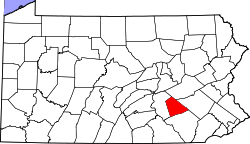Lebanon, Pennsylvania
| Lebanon, Pennsylvania | |
|---|---|
| City | |
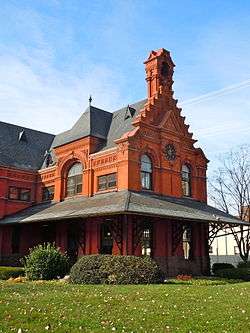 | |
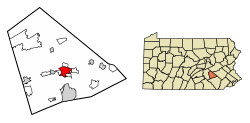 Location of Lebanon in Lebanon County, Pennsylvania | |
 Lebanon Location of Lebanon in Pennsylvania  Lebanon Lebanon (the US) | |
| Coordinates: 40°20′30″N 76°25′15″W / 40.34167°N 76.42083°WCoordinates: 40°20′30″N 76°25′15″W / 40.34167°N 76.42083°W | |
| Country | United States |
| State | Pennsylvania |
| County | Lebanon |
| Settled | 1720 |
| Incorporated | 1821 |
| Charter | 1885 |
| Government | |
| • Mayor | Sherry Capello (R) |
| Area[1] | |
| • Total | 4.17 sq mi (10.79 km2) |
| • Land | 4.17 sq mi (10.79 km2) |
| • Water | 0.00 sq mi (0.00 km2) |
| Population (2010) | |
| • Total | 25,477 |
| • Estimate (2016)[2] | 25,726 |
| • Density | 6,173.75/sq mi (2,383.53/km2) |
| Time zone | UTC−5 (EST) |
| • Summer (DST) | UTC−4 (EDT) |
| ZIP codes | 17042, 17046 |
| Area code(s) | 717 |
| FIPS code | 42-42168 |
| Website | http://www.lebanonpa.org |
Lebanon (/ˈlɛbənən/) is a city[3] in and the county seat of Lebanon County, Pennsylvania, United States.[4] The population was 25,477 at the 2010 census, a 4.2% increase from the 2000 count of 24,461. Lebanon is located in the central part of the Lebanon Valley, 26 miles (42 km) east of Harrisburg and 29 miles (47 km) west of Reading.
Lebanon was founded by George Steitz in 1740 and was originally named Steitztown.[5]
History
Native tribes in the area of what is now Lebanon included the Shawnee, Susquehannock, Gawanese, Lenape (or Delaware), and Nanticoke peoples.[6]
.jpg)
Lebanon was settled by European colonists in 1720, many with the family names of "Steitz" and "Light", along a creek that was then named "Steitz Creek". The Light patriarchs built a fort to protect against Indians and named it "Light's Fort". The town was laid out in 1753, incorporated as a borough on February 20, 1821, and became a city on November 25, 1885. It adopted the commission form of government, consisting of four councilmen and a mayor.
Lebanon bologna was first made here. Lebanon was formerly home to a major steel mill operated by Bethlehem Steel.
Geography
According to the United States Census Bureau, the city has a total area of 4.2 square miles (11 km2), all of it land.
Lebanon is bordered to the north and east by North Lebanon Township (4.5 mi), to the south and east by South Lebanon Township (3.22 mi), to the west by West Lebanon Township (1.07 mi), and to the south and west by North Cornwall Township (4.38 mi). The Quittapahilla Creek drains the city westward into the Susquehanna River via the Swatara Creek.
Demographics
| Historical population | |||
|---|---|---|---|
| Census | Pop. | %± | |
| 1790 | 960 | — | |
| 1800 | 1,439 | 49.9% | |
| 1810 | 1,434 | −0.3% | |
| 1820 | 1,437 | 0.2% | |
| 1830 | 1,826 | 27.1% | |
| 1840 | 1,860 | 1.9% | |
| 1850 | 2,184 | 17.4% | |
| 1860 | 4,449 | 103.7% | |
| 1870 | 6,727 | 51.2% | |
| 1880 | 8,778 | 30.5% | |
| 1890 | 14,664 | 67.1% | |
| 1900 | 17,628 | 20.2% | |
| 1910 | 19,240 | 9.1% | |
| 1920 | 24,643 | 28.1% | |
| 1930 | 25,561 | 3.7% | |
| 1940 | 27,206 | 6.4% | |
| 1950 | 28,156 | 3.5% | |
| 1960 | 30,045 | 6.7% | |
| 1970 | 28,572 | −4.9% | |
| 1980 | 25,711 | −10.0% | |
| 1990 | 24,800 | −3.5% | |
| 2000 | 24,461 | −1.4% | |
| 2010 | 25,477 | 4.2% | |
| Est. 2016 | 25,726 | [2] | 1.0% |
| Sources:[7][8][9][10] | |||
As of the 2010 census, the city was 74.1% White, 5.9% Black or African American, 0.5% Native American, 1.1% Asian, and 3.2% were two or more races. 32.1% of the population were of Hispanic of Latino ancestry .
As of the census[9] of 2000, there were 24,461 people, 10,266 households, and 6,056 families residing in the city. The population density was 5,844.8 people per square mile (2,254.0/km²). There were 11,220 housing units at an average density of 2,681.0 per square mile (1,033.9/km²). The racial makeup of the city was 85.50% White, 3.23% African American, 0.28% Native American, 1.02% Asian, 0.10% Pacific Islander, 8.11% from other races, and 1.76% from two or more races. Hispanic or Latino of any race were 16.43% of the population.
There were 10,266 households, out of which 28.4% had children under the age of 18 living with them, 38.7% were married couples living together, 15.0% had a female householder with no husband present, and 41.0% were non-families. 35.4% of all households were made up of individuals, and 15.3% had someone living alone who was 65 years of age or older. The average household size was 2.32 and the average family size was 3.00.
In the city, the population was spread out, with 25.0% under the age of 18, 8.4% from 18 to 24, 29.5% from 25 to 44, 20.5% from 45 to 64, and 16.6% who were 65 years of age or older. The median age was 36 years. For every 100 females, there were 94.1 males. For every 100 females age 18 and over, there were 90.8 males.
The median income for a household in the city was $27,259, and the median income for a family was $34,045. Males had a median income of $26,957 versus $20,162 for females. The per capita income for the city was $15,584. About 12.8% of families and 16.2% of the population were below the poverty line, including 24.7% of those under age 18 and 10.5% of those age 65 or over.
Education
Public education is provided by the Lebanon School District and Cornwall-Lebanon School District. Private institutions include Lebanon Catholic High School, Blue Mountain Christian School, New Covenant Christian School and Lebanon Christian Academy. All three private institutions have a varsity sports department and an elementary, junior high, and senior high. Students in Lebanon School District also may attend the Lebanon County Career and Technology Center (LCCTC). The city is home to Harrisburg Area Community College's Lebanon Campus.
Culture
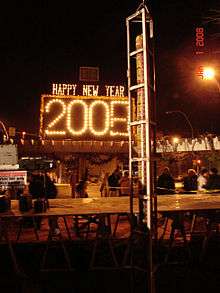
Lebanon, Pennsylvania, is named after the ancient Middle Eastern nation of Lebanon, which is commonly pronounced /ˈlɛbənɒn/, the last syllable rhyming with the name "John." However, locals consistently pronounce the Pennsylvania city's name /ˈlɛbənən/ ("Leb-a-nin") and many shorten it to two syllables—"Leb-nin" or even "Lep-nin." The latter is particularly identified with Pennsylvania Dutch heritage.[11]
An infamous 1878 murder in Fort Indiantown Gap resulted in a trial of six defendants who all had blue eyes. They were given the moniker the Blue-eyed Six by a newspaper reporter who attended the trial, held in the Lebanon county courthouse. Five of the six defendants were hanged at the county jail. The trial received worldwide publicity and provided inspiration to Arthur Conan Doyle in writing the Sherlock Holmes short story "The Red-Headed League" (1891).[12]
At one point in history the Lebanon County courthouse and jail became the home of the popular Lebanon Farmers Market. However, the market returned to the original 30,000 square foot Market House on South 8th street in 2003.
Lebanon is one of several Pennsylvania towns to drop or raise a unique item at midnight on New Year's Eve. Godshall's Quality Meats, owners of Weaver's Famous Lebanon Bologna, donates a 150-pound (68 kg) Lebanon bologna for the annual festivity. It is encased in a metal frame and suspended from a fire department ladder truck, and donated to a local rescue mission after the celebration.[13]
In December 2008, the TV show Dirty Jobs, hosted by Mike Rowe, visited the Seltzer's Smokehouse Meats to film production of Lebanon bologna.[14] In 2008 the show featured the Wertz Candy Shop.[15][16]
In 2010, an independent film drama Lebanon, PA was made.[17] While the movie was set in Lebanon, all filming was done in other parts of Pennsylvania.
Points of interest
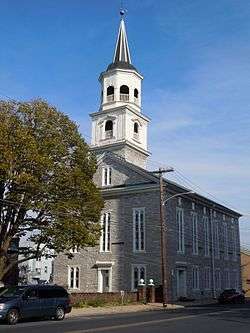
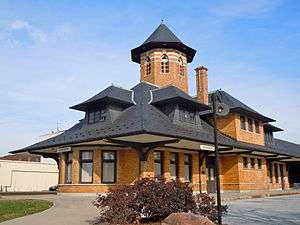
Local points of interest listed on the National Register of Historic Places[18] include:
Notable people
- Thomas Albert, composer
- Sam Bowie, NBA center
- Matt Busch, illustrator and professor at Macomb Community College
- Kerry Collins, former NFL quarterback
- Derek Fisher, outfielder for the Houston Astros
- Jacob G. Francis, founder of Elizabethtown College
- Bobby Gerhart, NASCAR/ARCA driver
- Jamie Lynn Gray, sport shooter and gold medalist at the 2012 Summer Olympics
- Betty Harte, silent-film actress
- Todd Klick, American writer
- Jared Odrick, NFL defensive end for the Miami Dolphins and Jacksonville Jaguars
- Frank Reich, former NFL quarterback and Head Coach of the Indianapolis Colts
- George S. Rentz, World War II Navy Cross recipient and United States Navy Chaplain
- Dick Shiner, former NFL quarterback
- James Buchanan, first member of the Lebanon County Bar Association
- Jaynne Berrier Bittner, pitcher All-American Girls Professional Baseball League
References
- ↑ "2016 U.S. Gazetteer Files". United States Census Bureau. Retrieved Aug 14, 2017.
- 1 2 "Population and Housing Unit Estimates". Retrieved June 9, 2017.
- ↑ "Home page". LebanonPA.org. Retrieved April 25, 2018.
- ↑ "Find a County". National Association of Counties. Retrieved 2011-06-07.
- ↑ "About Lebanon". www.lebanonpa.org.
- ↑ A Brief History of Lancaster County. Web.archive.org (1999-02-03). Retrieved on 2013-07-27.
- ↑ "Number of Inhabitants: Pennsylvania" (PDF). 18th Census of the United States. U.S. Census Bureau. Retrieved 22 November 2013.
- ↑ "Pennsylvania: Population and Housing Unit Counts" (PDF). U.S. Census Bureau. Retrieved 22 November 2013.
- 1 2 "American FactFinder". United States Census Bureau. Retrieved 2008-01-31.
- ↑ "Incorporated Places and Minor Civil Divisions Datasets: Subcounty Population Estimates: April 1, 2010 to July 1, 2012". U.S. Census Bureau. Archived from the original on 17 June 2013. Retrieved 25 November 2013.
- ↑ Lady, The Apple (19 August 2007). "The Daily Apple: Apple #261: Wilkes-Barre, PA".
- ↑ Ludwig, Gary (1979). The Blue Eyed Six, A Historical Narrative. Lebanon, PA: Hodge Podge USA.
- ↑ "WHT.com news story".
- ↑ "Discovery Channel hit to give bologna its 10 minutes of fame". Archived from the original on 2008-08-24.
- ↑ "TV.com episode recap".
- ↑ "'Dirty Jobs' star auctioning special candy from Wertz Candies of Lebanon".
- ↑ "Home Decor Inspirations". lebanonpamovie.com.
- ↑ National Park Service (2010-07-09). "National Register Information System". National Register of Historic Places. National Park Service.
External links
| Wikimedia Commons has media related to Lebanon, Pennsylvania. |
| Wikisource has the text of an 1879 American Cyclopædia article about Lebanon, Pennsylvania. |
